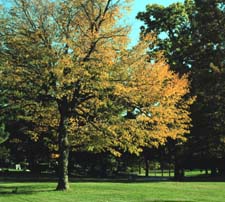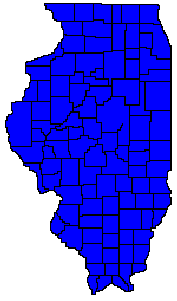 |
| Hop
Hornbeam (Ostrya virginiana)
Distribution
Map to Right |

Hop hornbeam is a small tree, typically reaching a maximum height of 30 feet with a proportionally short, straight trunk of 1 foot in diameter. The crown is broad and rounded or vase-shaped. Hop hornbeam is a common tree throughout the eastern United States. It occurs in every county in Illinois in a variety of habitats from stream banks to upland woods and dry, rocky slopes and ridges.
Interesting
Facts
European farmers used relatives of the hop hornbeam to make yokes for oxen, from whence the name "hornbeam" arises. These trees were also referred to as "yoke-elms."
Hop hornbeam is sometimes confused with ironwood (Carpinus caroliniana), also known as blue beech. The latter has a very smooth gray trunk that has a "muscular" appearance (hence the name ironwood), whereas hop hornbeam has brownish, grooved, and scaly bark. Nonetheless, the term ironwood is applied to both the hop hornbeam (Ostrya virginiana) and the blue beech (Carpinus caroliniana) in some texts.
The leaves of hop hornbeam are similar to those of ironwood, and also to those of elms. The distinguishing characteristic that separates the elm leaves from the hop hornbeam leaves is the asymmetrical base common in elm leaves. Hop hornbeams do not have leaves with an asymmetrical base.
Identifying Features
BarkUses
Hop hornbeam bark is reddish-brown and smooth, with obvious lenticels (small, ringed holes in the surface of the bark through which gasses are exchanged) when the tree is young. In fact, when young, the bark looks very much like that of a young cherry tree. As the tree matures, the bark becomes gray-brown, scaly, loose, and shreds.
Twigs
The twigs are also reddish-brown and can be smooth or hairy. They are slender, yet resilient and do not snap easily.
Buds
The buds are yellowish green, small, and pointed at the tip.
Leaves
Leaves are alternate and simple. The leaf stalks are very short and hairy. The leaf blades are 2 to 4 inches long and are lance shaped or oval. They have double-toothed edges, are dark green and only slightly hairy or smooth above, and paler and hairier below.
Flowers
Both male and female flowers are borne on the same tree, but as separate flowers. The male flowers occur as catkins, which persist on the tree through the winter and open in late April or May.
Fruits
The fruits are nutlets contained in papery sacks that occur in clusters that hang from the tree.
Hop hornbeam wood is hard and durable. It is used chiefly in the manufacture of tool handles, but also for fence posts and fuel. Hop hornbeam serves well as a landscape tree owing to its tolerance for very dry soils and shade, as well as its ability to live in a stressful urban environment. Native Americans used hop hornbeam to treat toothache and sore muscles, coughs, hemorrhages in the lungs, kidney disease, tuberculosis, and a host of other ailments.